
|
 |
Supermarine Spitfire |
 |
 |
 |
 |
 |
|---|---|---|---|---|---|---|---|
 |
 |
 |
 |
 |
|||
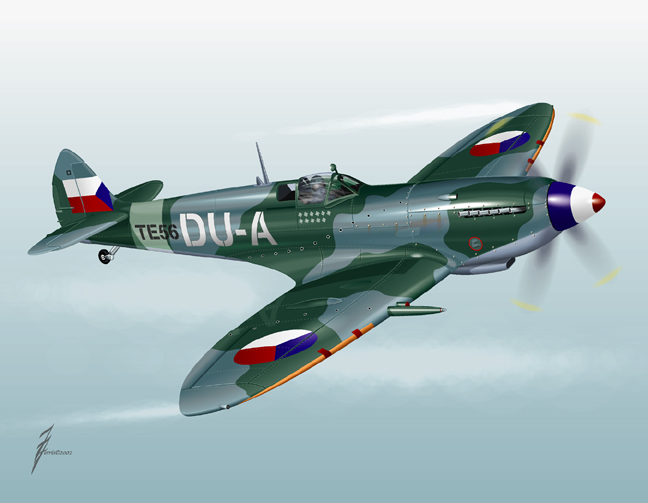 |
||
|
If you can see the video controls but the video doesn't play click the link below. It was the design of Reginald J. Mitchell, chief designer of Supermarine Aviation Works, a subsidiary of Vickers-Armstrong. It was a direct descendant of a series of floatplanes built to compete for the Schneider Trophy in the 1920s and 30s, one of which was the Supermarine S.6B. The S.6B was powered by a 2,300 hp (1,715 kW) PV.12 Rolls-Royce engine—this engine would later become the famous Rolls-Royce Merlin. The S.6B won the 1931 Schneider Trophy in 1931 at a record speed of 340.08 mph (547.19 km/h) and would break the world speed record again in seventeen days at 407.5 mph (655.67 km/h). This was more than 200 mph (322 km/h) faster than any airplane in the RAF. Mitchell continued to refine the Spitfire until his death at age 42 from cancer in 1937, where work continued under Chief Engineer Joseph Smith. Deliveries of production Spitfire Is began in June 1938, just over two years after 'Mutt' Summers flew the first prototype at Southhampton. In the two years preceding production, Supermarine laid out their Woolston factory for large-scale production, and organized one of the largest subcontracting programs ever envisioned in Britain. Until that time, as it was becoming increasingly evident that there was no limit to the likely demand for Spitfires. It was also obvious that one factory alone was not going to be able to meet the demand, even with subcontracting. |
| Large scale plans were laid during 1937 for the construction, by the Nuffield Group, of a large new shadow factory at Castle Bromwich near Birmingham for Spitfire production. On April 12, 1938, a contract was placed for 1,000 Spitfires to be built at this new factory, of which the actual construction had not then even begun. By the time of the Munich crisis on 12-13 September, 1938, only five Spitfires had been completed.1 In the following year, on April 29, further contracts were placed with Supermarine for 200 Spitfires, and on August 9 for 450. When Britain went to war on September 3, 1939 a total of 2,160 Spitfires were already on order.2 |
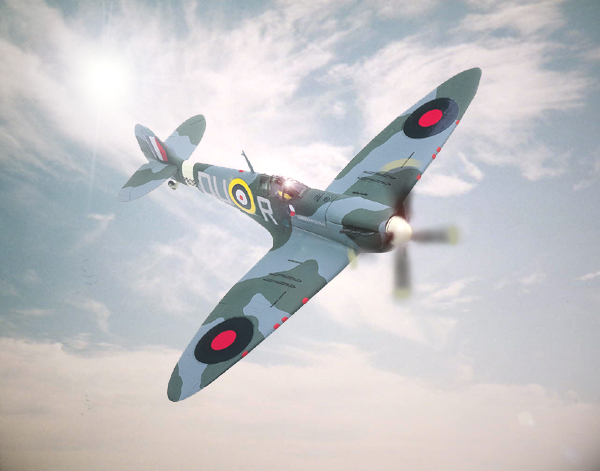 |
|---|
|
Shown above is the Spitfire Mk IIA of WWII ace Flt. Lt. Adolphe Vybiral. No 312 Czechoslovak Squadron RAF, formed at Duxford with Hurricanes on the 29th of August 1940 with Czechoslovak personnel as a fighter unit. The squadron moved to various bases and re-equipped with the Spitfire Mk.IIA in October 1941, which it flew for three months before converting to later Mk Spitfires. The squadron was disbanded after the war in 1946.
|
|
Structurally, the Spitfire was a straightforward design with a light alloy monocoque fuselage and a single spar wing, with stressed-skin covering and fabric-covered control surfaces. The elliptical wing was very thin compared to the standard at the time and was adapted from Mitchell's aesthetically pleasing 1925 S.4 design.
To preserve the clean nose-cowling lines originally conceived by Mitchell, the radiator was located beneath the starboard wing with the smaller oil cooler causing some asymmetry beneath the port wing, and the carburetor air intake under the center fuselage. A de Havilland two-blade wooden fixed-pitch propeller was employed by the prototype, and the first Spitfire Is had the Airscrew Company's wooden fixed-pitch two-blade. Later on, a de Havilland three-blade, two position propeller was adopted after trials on the first prototype. The new propeller gave a 5 mph increase in speed. In 1940, de Havilland three-blade constant-speed propeller was substituted. Production Spitfires had a fixed tail wheel, and triple ejector exhaust manifolds.3 It was powered by a 1,000 hp (745 kW) Rolls-Royce PV.12 engine, which would become the Rolls-Royce Merlin engine.4 |
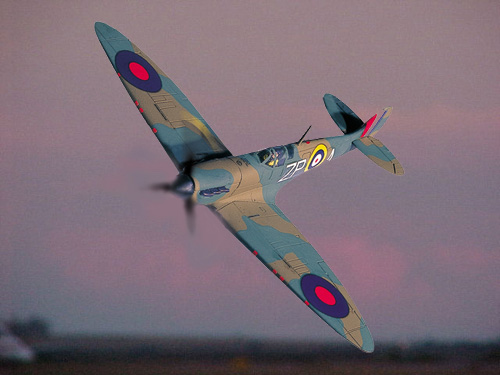 |
|---|
|
On the morning of the 10th of July 1940, a convoy codenamed 'Bread' was detected by a reconnaissance Dornier Do17P of 4(F)1 21 when rounding the North Foreland in Kent. Six Spitfires of No.74 Sqn (Hornchurch) intercepted but were outnumbered by more than 20 Bf 109s of I/JG 51. Despite this they forced the Dornier to crash land, while only taking damage to two of the Spitfires. K9953/ZP-A was flown by Flight Lt. Adolf 'Sailor' Malan of the No.74 Sqn during this action. It went to No.7 OTU after the Battle of Britain before being passed to No.57 OTU where it was wrecked in a collision in 1943.
|
|
The Spitfire I weighed 5,280 lb. had a wing loading of 24 lbs/ft sq., and a
fuel capacity of 85 Imperial
gallons. Its maximum speed was 362 mph, its maximum diving speed was 450 mph, its initial climb
rate was 2,500 ft./min., and it took 9.4 minutes to climb to 20,000 feet. Its combat range was 395
miles and its roll rate was 140 deg/sec. Standard armament in what was
known as the "A wing" was eight 0.303-in. Browning machine-guns with 300 rounds of
ammunition. The speed of the Spitfire I was marginally higher than that of its principal opponent
the Luftwaffe's
Messerschmitt Bf 109E, and it
was infinitely more maneuverable than the German fighter although the
Bf 109E
could out climb and out dive the British fighter, and its shell-firing
cannon had a longer range than the Spitfire's machine-guns.5
The 1,175 hp Merlin XII was adopted as the standard power plant in the Type 329 Spitfire II, with a Rotol three-blade propeller and 73 lb. of amour protection but this variant was otherwise similar to the Spitfire I. Deliveries of the Spitfire Mk IIs began in 1940 following the Mark I production lines, and became the first major production variant to be delivered from Castle Bromwich. By April 1941, 650 Mk IIs had left the Bromwich factory, and the changeover was complete. Most of the Mk Is were then relegated to the training role.6 In 1941 the Merlin 45 series of two-stage single-speed engines were adopted and the Type 349 Spitfire V so powered, followed the Mark II into production and service. The Spitfire V loaded weight had crept up to 6,417 lb. and the maximum speed up to 369 mph. The first squadron to fly the Spitfire V was the No. 92 and in March 1942, fifteen Spitfire VBs which had been shipped to Malta on HMS Eagle, became the first Spitfires to serve outside Europe. Spitfires of this Mark were later to serve in the Western Desert, and the Pacific and Burma areas.7 |
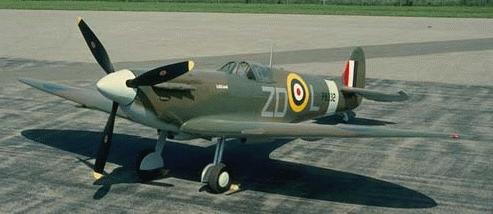 |
|---|
|
A restored Spitfire Mk IIB Photo - Canada Aviation Museum. |
|
In the normal course of development, means were sought to increase the
altitude performance of the Spitfire, which was inferior to that of the
Messerschmitt Bf 109E . This called for two principal modifications, the introduction of a pressurized cabin and the use of an engine suitably rated for higher
altitude. The first version of the Spitfire so equipped, was the Mark VI
derived directly from the Mark VB, as a result of work on pressure cabins
at the Royal Aircraft Establishment and Supermarine during 1940-41. At the
R.A.E., R7120 was fitted with a Merlin 47 (the high rated version of the
Merlin 45) with a four-blade Rotol propeller with Jablo blades and a
pressure cabin. The same engine was employed by the 100 Spitfire VI
(Type 350) fighters, built by Supermarine, the first two of these AB176 and
X4942 serving as prototypes. The production Spitfire VI also had an
increase in wing area to improve controllability at high altitudes, the wing
being of pointed planform with a span of 40 ft. 2 in. The pressure cabin
was contained between the bulkheads fore and aft of the cockpit, and a
special non-sliding hood was fitted to simplify the sealing problem. A
Marshall blower provided a cabin differential of 2 lb./s. in., reducing
apparent altitude from 40,000 feet to 28,000 feet. In other respects
including armament the Spitfire VI was similar to the Mark VB.8
The Spitfire VII (Type 351) was a more extensive re-design for high-altitude work, and was the first of the Spitfire series intended to make use of the two speed Merlin 60 series of engines. These two-stage engines were coupled with a re-designed cooling system which showed itself in the enlarged air intake under the port wing matching that to starboard. The wing outline remained similar to that of the Spitfire VI, but the ailerons were reduced in span. The chord and area of the rudder were increased and the elevator horn balance was extended. Structural changes were made to the fuselage to take the increased engine loads and a double-glaze sliding hood was fitted to the cockpit. The retractable tail wheel first developed for the Spitfire III, was applied in production for the first time on the Mark VII and the universal C -type wing was employed. Maximum speed jumped by 44 mph to 408 mph and normal loaded weight climbed to 7,875 lbs.9 |
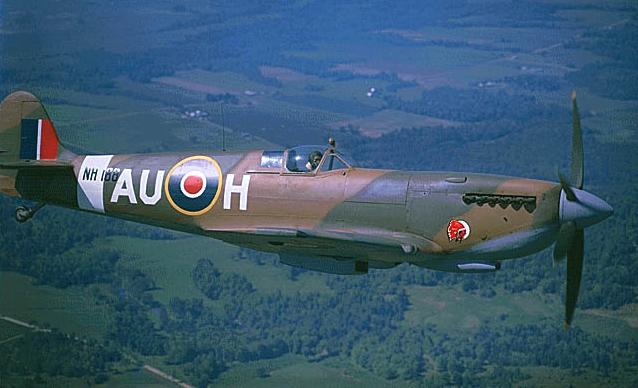 |
|---|
|
A Second World War vintage Supermarine Spitfire Mk.IX (L.F.),
rebuilt by Canada's National Aviation Museum. The L.F. was the
low-altitude version of the Mk.IX, configured with a Merlin 66 engine
and clipped elliptical wings. Normal armament was two 20mm cannon and
four machine-guns. The Mk.IX entered service in late 1942.
(Photo: Canadian Forces)
|
| Production of some 40 different variants of the Spitfire took place throughout the war and after. They served in every combat area, operating as fighters, fighter-bombers, reconnaissance aircraft and carrier-based fighters with the Royal Navy. Griffon engines replaced Merlins after a time, and the Spitfire XIX reconnaissance version became the fastest of all the wartime Spitfires with a speed of nearly 460 mph (748 km/h). The last Spitfire was built in 1947. As a fighter, at all altitudes it had proved superb, while continuous edges gained firstly by German Bf 109s and Focke Wulfs 190s and then by different versions of the Spitfire led to closely-matched battles throughout the war. 10 |
| Specifications: | ||
|---|---|---|
| Mk VB | Mk XIV | |
| Dimensions: | ||
| Wing span: | 36 ft 10 in (11.23 m) | 36 ft 10 in (11.23 m) |
| Length: | 29 ft 11 in (9.11 m) | 32 ft 8 in (9.95 m) |
| Height: | 11 ft 5 in (3.63 m) | 12 ft 8 in (3.85 m) |
| Weights: | ||
| Empty: | 5,065 lb. (2,297 kg) | 6,600 lb. (2,993 kg) |
| Loaded: | 6,650 lb (3,016 kg) | 8,500 lb (3,855 kg) |
| Performance: | ||
| Maximum Speed: |
374 mph (601 km/h) @ 13,000 ft (3,962 m) |
448 mph (720 km/h) @ 26,000 ft (7,924 m) |
| Service Ceiling: | 37,000 ft. (11,277 m) | 44,500 ft. (13,563 m) |
| Range: | 1,135 miles (1,826 km) | 850 miles (1,367 km) |
| Powerplant Mk VB: | Powerplant Mk XIV: |
|---|---|
|
Rolls Royce Merlin 45, 1,440 hp, (1,073 kw), Vee 12 cylinder, Liquid-cooled. |
Rolls Royce Griffon 65, 2,050 hp, (1,528 kw), Vee 12 cylinder, Liquid-cooled. |
| Armament Mk VB: | Armament Mk XIV: |
|
Two 20 mm cannon and four .303 caliber machine guns,
external bomb load of one 500 lb (226 kg) or two 250 lb (113 kg). |
Two 20 mm cannon and four .303 caliber machine guns,
external bomb load of 1,000 lb (454 kg). |
|
1. David Donald. The Complete Encyclopedia of World Aircraft. New York: Barnes & Noble Inc., 1998. 871. 2. William Green. Famous Fighters of the Second World War. New York: Doubleday and Company, 1967. 26. 3. Ibid. 4. Bill Gunston. Aircraft of World War II. New York: Crescent Books, 1980. 193. 5. Green. 27. 6. Philip J.R. Moyes. Aircraft in Profile, The Supermarine Spitfire I & II. New York: Doubleday and Company, 1965. 7. Green. 28. 8. Green. 30. 9. Green. 31. 10. Taylor, Michael J.H. and John W.R. Taylor. Encyclopedia of Aircraft. New York: G.P. Putnam's Sons, 1978. 209. |
© Larry Dwyer. The Aviation History Online Museum.
All rights reserved.
Created October 19, 1997. Updated December 28, 2022.